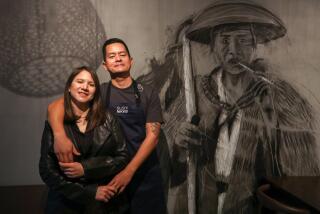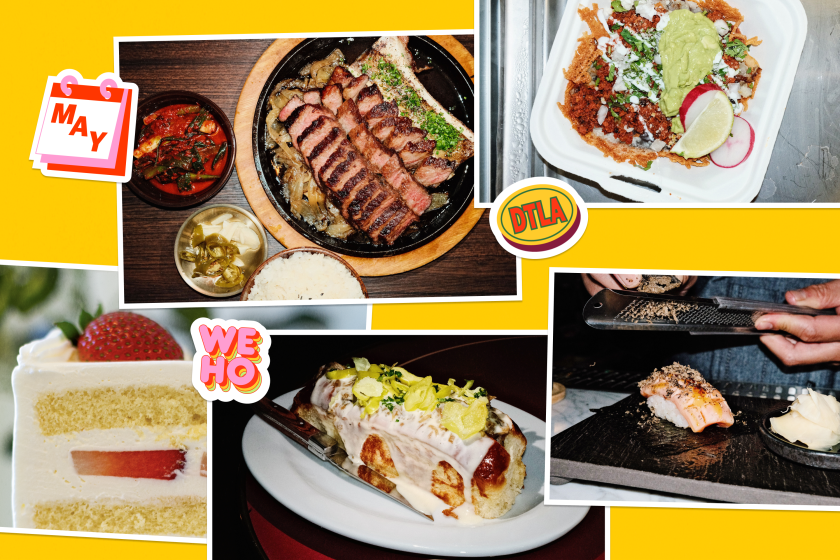The Egg and Moi
Questions, we had questions.
Why is this apron string so long?
(So you can tie it in front on you.)
Should we sharpen our kitchen knives toward us or away?
(Mon dieu, always toward you, man. Look how close you’re standing to everyone else!)
*
After a very long plane trip from Los Angeles, there we were--Dodie, my 81-year-old mother-in-law, my wife, Barbara, and me--in the fabled La Varenne student kitchen at Chateau du Fey in the rolling Burgundian countryside. The time was 8:45 a.m. Monday morning, and the first guest chef was Patrick Gauthier, looking intently at the recipes ahead--and at us.
Preparing lunch was to be a taxing affair for the 18 students. We had a bit more than three hours. Luckily, as newbies, we were assigned to the pastry kitchen to work with Chef de Cuisine Randall Price, the teddy bear chef, whom you may have seen as a host on the Travel Channel.
In the midst of my jet-lag haze, as I was working egg yolk from white, I managed to squish driblets of the yolk into about a half-gallon of pure whites.
“Oh, my God, what are you doing!” Price yelled as he raced over to me, chef-commando-style. “Now, we’ll never be able to fluff any of them.”
I felt very, very small. Tiny, in fact.
Then, he leaned over conspiratorially and added, “Luckily, we have about three more of those in the refrigerator, but next time use a couple of small bowls.”
There were potatoes to peel, squid to peel, tomatoes to peel, shallots to peel. So many ingredients, so little time.
As the week progressed, we got used to economizing our personal space as the dozen and a half of us stirred, squatted, lifted, chopped and shimmied our way through one example of cuisine regionale after another.
Chef, of course, was not always pleased with our hard work. He would walk through the kitchen, playing the part of a Michelin three-star general very well, slapping the back of one hand into the palm of the other, reciting, “Vite, Molly, vite!”
And Molly Stevens, the kitchen director, would properly intone the correct response, “Oui, chef,” even while courteously reminding a student that tomato bottoms are scored, not cut, before immersing in hot water, or that the clicker to light the stove-top burner was over there in the same place it had always been.
There were other moments as well, as when the team I was on managed to create slightly lumpy creme pa^tissiere for chef’s dessert.
Chef Jean-Michel Bouvier crossed his hands and asked, “Did you forget to add flour?”
Momentary panic--yes, no, who could remember?
The morning had been an assembly blur of different projects that were given out on a strictly need-to-know basis. I had separated a bunch of eggs into yolks and whites without spoiling vast quantities of whites. I had beaten egg yolks and sugar with a whisk until both arms were ready to come off. And, no, I could never quite get the hang of the classic “figure eight” motion, opting for the easier circle instead. And I had added the seeds of vanilla beans and the beans themselves to scalding milk, then strained the lot.
Then came a flash of memory.
“Oui, chef!” I proclaimed, we had added flour. But the pastry cream was still lumpy!
“The professional knows how to fix it,” he said, racing out of the kitchen, only to return with a bottle of Grand Marnier. He poured a dram, whisked, tasted, had me taste and then, to my horror, poured in almost the entire bottle. With vigorous, confident whisking, the tiny lumps disappeared.
Just how fussy the French are about their food became apparent as our creme pa^tissiere became creme legere with the addition of whipped cream, and then disappeared into the nether world of feuillete de poire au caramel, a mere comfy bed for the pears. Bouvier then finished off the dish with a red-hot spatula he used to caramelize the sugar atop each individual serving. His skill was breathtaking, his attitude oppressive.
Meanwhile, my mother-in-law proved to excel at crapiaux Morvandiaux, the potato pancakes that were the fruit of my wife’s excellent mandoline work. We had learned earlier that this unwieldy contraption was by far the most dangerous in a professional kitchen, because there is nothing to stop the palm of your hand from running across the very sharp cutting blade as the object you slice gets smaller and smaller.
Linda Gray of “Dallas” fame and screenwriter-producer beau Dan Gordon took turns learning the intricacies of making omelets.
Why do you clean an omelet pan with rock salt? If the pan isn’t clean, the eggs will stick, ruining your omelet bourguignonne aux escargots.
“Why,” Seattle dentist Dennis Smith had the courage to ask, “don’t we use Teflon-coated pans?”
“You could,” snapped Chef Claude Godard, “but it’s not traditional.”
Gordon had the thrill of cooking the first complete omelet, and, yes, we all cheered as he turned it over in the pan without tearing it. Soon Dennis’ 13-year-old son, Daniel, was also at the omelet station under the critical eye of the chef. I’m happy to say that his flip was not a flop.
But, alas, my own potato pancake was getting too brown on the bottom. Chef’s solution: You must float the potato mixture on the oil, like a raft in white water. I must admit to being content stateside with a skin of oil so thin that it barely glistens in the pan.
“More oil,” he said with confidence, pouring in a good quarter-inch, and I wondered to myself how any people who ate this way could be so thin.
And with more oil, things did markedly improve. Buoyed by the golden liquid, and a blossoming esprit de corps, we began sauteing pancakes in three sizes of pans, pikers no more.
All was properly in order when the school’s founder and president, Anne Willan, came in to review the various dishes, which we had laboriously laid out on serving plates and garnished under the chef’s direction. Since founding La Varenne in Paris in 1975, she has gained enough respect that her criticism of a chef’s dish--wrong color choice, incorrect plate (too big, too small, too formal, not formal enough), weak presentation--is taken to heart, even by the most prideful.
Even though the three of us--my mother-in-law, my wife and I--at times felt totally at sea, we came out the other end of our week with diplomas in our hands. And, yes, all of our questions were answered.
Back in Los Angeles and again bleary with jet lag, we cooked a farewell dinner for Dodie before she returned to her home in La Conner, Wash.
Gougere, light puffs of pastry filled with cheese, ham and bechamel sauce, seemed a natural choice. Chef Gauthier had shown the three of us how to work the dough, slowly adding more and more air. Barbara and Dodie worked with a new vigor around our small kitchen, each avoiding the other in a dance learned far away. I was content to set the table, open the wine and watch the action.
GOUGERE
PASTRY
3/4 cup flour
3/4 cup water
1 teaspoon salt
5 tablespoons butter plus extra for buttering pie plate
3 to 4 eggs
Pepper
1/2 cup diced Gruyere cheese
BECHAMEL SAUCE
2 cups milk
1 slice onion
1 bay leaf
6 peppercorns
2 tablespoons butter
1/4 cup flour
Salt, white pepper
Dash grated nutmeg
1 cup diced cooked ham
PASTRY
Sift flour onto piece of wax paper.
Bring water, salt and butter to boil in saucepan and remove from heat.
Add flour immediately and beat vigorously with wooden spatula until mixture is smooth and pulls away from pan to form ball, 20 to 30 seconds. Return pan to stove and cook over low heat, beating in dry mixture, 30 seconds to 1 minute.
Beat 1 egg in small bowl and set aside. Beat remaining eggs into dough with wooden spatula one at a time, beating thoroughly after each addition. Beat enough of reserved egg into dough to make mixture that is shiny and just falls from spoon. (All of reserved egg may not be needed. If you add too much, dough can’t be shaped.) Stir in cheese.
Arrange dough in puffs about half the size of a fist around perimeter of buttered 9-inch pie plate or baking dish, leaving hollow in center. Bake at 400 degrees until dough is puffed and browned, 30 to 40 minutes.
BECHAMEL SAUCE
Scald milk in saucepan. Remove from heat and add onion, bay leaf and peppercorns and infuse 5 to 10 minutes.
Melt butter over medium heat in heavy saucepan. Whisk in flour and cook until foaming but not brown, 1 to 2 minutes. Cool. Strain in hot milk and whisk well. Bring sauce to boil over medium heat, whisking constantly. Add salt, pepper and nutmeg and simmer 3 to 5 minutes. If you don’t use the sauce at once, rub its surface with butter to prevent skin from forming. (Sauce may be kept 2 to 3 days in refrigerator.) Reheat gently before using.
Spoon Bechamel Sauce and ham into center of ring and return to oven 3 to 5 minutes to reheat filling. Serve immediately.
6 to 8 servings. Each of 8 servings:
251 calories; 730 mg sodium; 126 mg cholesterol; 16 grams fat; 15 grams carbohydrates; 11 grams protein; 0.06 gram fiber.
More to Read
Eat your way across L.A.
Get our weekly Tasting Notes newsletter for reviews, news and more.
You may occasionally receive promotional content from the Los Angeles Times.






